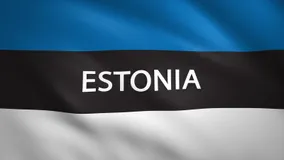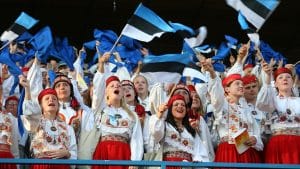Headlines
Estonia Population, Official Language And More.

Since then, Estonia has been a successful and stable democracy, joining the European Union, NATO, and the eurozone. It has also developed a modern and innovative economy, based on information technology, e-government, and renewable energy. It has maintained good relations with its neighbors and allies, and promoted regional cooperation and security. Estonia has also preserved and celebrated its unique culture, language, and traditions, while embracing diversity and openness.

Estonia
The population
Estonia has a population of about 1.3 million people, which is expected to decline in the coming years due to low fertility rates and emigration. The majority of the population are ethnic Estonians, who speak Estonian as their native language. The largest minority group are Russians, who make up about 22% of the population and mostly speak Russian. Other minority groups include Ukrainians, Poles, Finns, and others. Estonia is a member of the European Union and NATO, and has a high level of human development and digitalization.
The landmarks
Estonia has many historical and cultural landmarks that reflect its diverse heritage and natural beauty. Some of the most famous landmarks include:
- Tallinn Old Town, a UNESCO World Heritage Site that preserves the medieval architecture and atmosphere of the capital city. It features many attractions such as Toompea Castle, Alexander Nevsky Cathedral, St. Olaf’s Church, and Town Hall Square.
- Kadriorg Palace, a Baroque style palace built by Peter the Great of Russia in the 18th century. It houses an art museum and is surrounded by a large park with a swan pond.
- Seaplane Harbour, a maritime museum that displays various ships, submarines, and seaplanes in a former seaplane hangar. It also offers interactive exhibits and simulators for visitors.
- Kumu Art Museum, a modern art museum that showcases Estonian and international art from the 18th century to the present day. It is located in a striking building that won the European Museum of the Year Award in 2008.
The official language
The official language of Estonia is Estonian, a Finnic language that belongs to the Uralic language family. It is closely related to Finnish and distantly to Hungarian. Estonian is written in the Latin script and has 14 cases and three grammatical genders. It has also borrowed many words from Germanic languages, especially from German and Swedish. Estonian is spoken by about 1.1 million people in Estonia and abroad.
The culture
The culture of Estonia combines an indigenous heritage, represented by the Finnic national language and folklore, with Nordic and German cultural aspects. The culture of Estonia is also influenced by the traditions of other neighboring peoples, such as the Baltic Germans, Balts, Slavs, Swedes, Danes, and Russians. Estonia has a rich literary tradition, dating back to the 13th century. The national epic is Kalevipoeg, based on ancient folk poetry. Some of the most prominent Estonian writers include Lydia Koidula, Eduard Vilde, Anton Hansen Tammsaare, Jaan Kross, and Andrus Kivirähk. Estonia is also known for its music and performing arts, especially for its choral singing and song festivals. Some of the most famous Estonian composers include Arvo Pärt, Veljo Tormis, Erkki-Sven Tüür, and Eino Tamberg. Estonia has also produced many acclaimed filmmakers, such as Rein Maran, Priit Pärn, Jaak Kilmi, Veiko Õunpuu, and Tanel Toom.
The economic stability
Estonia has a market-based economy that is highly integrated with the European Union. It has a strong fiscal policy, a low public debt level, a flexible labor market, and a competitive business environment. Estonia is also a leader in digital governance and innovation, offering various e-services to its citizens and businesses. Estonia’s main economic sectors are services, industry, agriculture, and tourism. Its main exports are machinery and equipment, wood products, metals, food products, and textiles. Its main trading partners are Finland, Sweden, Latvia, Germany, and Russia. Estonia’s economy was severely affected by the COVID-19 pandemic in 2020 but recovered strongly in 2021 thanks to effective containment measures and fiscal support. The economic outlook for 2022-2023 is positive but subject to uncertainty due to external risks such as rising energy prices and geopolitical tensions.
- GDP: Estonia’s GDP was worth 38.10 billion US dollars in 2022, according to official data from the World Bank. The GDP value of Estonia represents 0.02 percent of the world economy. GDP in Estonia averaged 15.56 USD Billion from 1987 until 2022, reaching an all time high of 38.10 USD Billion in 2022 and a record low of 3.99 USD Billion in 1987. GDP in Estonia is expected to reach 37.72 USD Billion by the end of 2023, according to Trading Economics global macro models and analysts expectations.
- Currency: The currency in Estonia is the euro, with symbol € and currency code EUR. Estonia adopted the euro on January 1, 2011, replacing the Estonian kroon at a fixed exchange rate of 1 EUR = 15.6466 EEK. The euro is divided into 100 cents and is used as the official legal tender in Estonia and other 18 member states of the European Union. As of February 10, 2023, one euro is equal to 1.13 US dollars.
- Food: Estonian food is influenced by various cultures and powers that have ruled over the country for centuries, such as German, Russian, Scandinavian, and Baltic cuisines. Estonian food is typically hearty, simple, and seasonal, using local ingredients such as potatoes, rye bread, pork, fish, dairy products, berries, and mushrooms. Some of the most popular and traditional dishes in Estonia are:
- Sprats: Small oily fish that are smoked, canned, or pickled in a spicy brine. Sprats are often eaten as a snack or on a sandwich with boiled eggs and sauce.
- Mulgipuder: A national dish of mashed potatoes and groat (barley), mixed with butter and bacon sauce. Mulgipuder was once considered a luxurious dish for special occasions.
- Rye bread: A staple in the Estonian cuisine, made from rye flour and sourdough starter. Rye bread is dark, dense, and sour, and is often flavored with caraway seeds or malt. Rye bread is eaten with almost every meal and can be used to make desserts or drinks.
- Smoked fish: A summer delicacy in Estonia, especially on the islands and coastal areas. Smoked fish can be bought fresh from local fishermen or markets, or prepared at home with different spices and herbs.
- Verivorst: Blood sausage made from pork blood, barley, and spices, stuffed into casings and boiled or smoked. Verivorst is a common Christmas food in Estonia, usually served with sauerkraut and lingonberry jam.
- Sünnipäevasalat: Birthday salad made from potatoes, eggs, green peas, cucumber, onion, sausage, dill, parsley, mayonnaise, and sour cream. Sünnipäevasalat is a festive dish that is often served at birthday parties or other celebrations.
- Aspic: A jelly-like dish made from meat stock and pieces of meat, seafood, or eggs. Aspic is flavored with vinegar, salt, pepper, bay leaves, cloves, and other spices. Aspic is eaten cold as an appetizer or a main course.
- Pickled food: A variety of food items that are preserved in vinegar, salt, sugar, water, and spices. Pickled food includes cucumbers, mushrooms, fish, cabbage, beets, garlic, tomatoes, and more. Pickled food is popular in Estonia for its long shelf life and tangy taste.
- Major cities: Estonia has 47 cities and towns (linn), which are urban settlements with more than 5 000 inhabitants and self-governing status. The five biggest cities in Estonia by population are:
- Tallinn: The capital and the largest city of Estonia, covering an area of 159 square kilometers with a population of 430 805 as of 2018. Tallinn is a historical and cultural center of Estonia, as well as a major financial and technological hub. Tallinn’s old town is one of the best preserved medieval cities in Europe and a UNESCO World Heritage Site.
- Tartu: The second largest city of Estonia, covering an area of 40 square kilometers with a population of 93 715 as of 2018. Tartu is the intellectual and educational center of Estonia, home to the University of Tartu, the oldest and most prestigious university in the country. Tartu is also known for its lively cultural scene and historical landmarks.
- Narva: The third largest city of Estonia, covering an area of 60 square kilometers with a population of 56 103 as of 2018. Narva is located on the eastern border of Estonia, next to Russia. Narva is a multicultural city with a predominantly Russian-speaking population. Narva’s main attraction is the Narva Castle, a 13th-century fortress that faces the Ivangorod Castle on the Russian side of the Narva River.
- Pärnu: The fourth largest city of Estonia, covering an area of 33 square kilometers with a population of 39 375 as of 2018. Pärnu is situated on the southwest coast of Estonia, on the Gulf of Riga. Pärnu is the official summer capital of Estonia and a popular tourist destination for its sandy beaches, spas, and festivals.
- Kohtla-Järve: The fifth largest city of Estonia, covering an area of 120 square kilometers with a population of 34 394 as of 2018. Kohtla-Järve is located in the northeast of Estonia, in the Ida-Viru County. Kohtla-Järve is an industrial city that was founded in 1946 as a center for oil shale mining and processing. Kohtla-Järve is also known for its diverse ethnic composition and cultural events.
- Major airports, sea ports and schools: Estonia has several major airports, sea ports and schools that serve its transportation, trade and education needs. Some of them are:
- Airports: Estonia has 19 airports with paved runways, of which six have scheduled passenger service on a commercial airline. The largest and busiest airport in Estonia is Tallinn Airport (TLL), which serves as the main international gateway to the country. Tallinn Airport handled 3.26 million passengers and 30,869 aircraft movements in 2019. Other major airports in Estonia include Tartu Airport (TAY), Kuressaare Airport (URE), Kärdla Airport (KDL), Pärnu Airport (EPU), and Narva Airport (NAVA).
- Sea ports: Estonia has several sea ports that are located along its 3,794-kilometer coastline on the Baltic Sea and the Gulf of Finland. The largest and most important sea port in Estonia is the Port of Tallinn, which consists of five constituent harbors: Old City Harbor, Muuga Harbor, Paldiski South Harbor, Paljassaare Harbor, and Saaremaa Harbor. The Port of Tallinn handled 19.9 million tons of cargo and 10.6 million passengers in 2019. Other major sea ports in Estonia include the Port of Sillamäe, the Port of Paldiski, the Port of Kunda, and the Port of Pärnu.
- Schools: Estonia has a well-developed and high-performing education system that consists of four levels: pre-primary, basic, secondary, and higher education. According to the Programme for International Student Assessment (PISA), Estonian students rank among the top performers in reading, mathematics, and science in the world. There are about 500 general education schools, 50 vocational education institutions, and 19 higher education institutions in Estonia. Some of the most prestigious and renowned schools in Estonia are:
- University of Tartu: The oldest and most prestigious university in Estonia, founded in 1632. It offers bachelor’s, master’s, and doctoral programs in various fields of study. It has about 13,000 students and 1,300 academic staff. It is ranked among the top 300 universities in the world by QS World University Rankings.
- Tallinn University of Technology: The only technological university in Estonia, founded in 1918. It offers bachelor’s, master’s, and doctoral programs in engineering, natural sciences, business, social sciences, and humanities. It has about 11,000 students and 1,600 academic staff. It is ranked among the top 500 universities in the world by QS World University Rankings.
- Tallinn University: The third-largest university in Estonia, founded in 2005. It offers bachelor’s, master’s, and doctoral programs in education, humanities, arts, social sciences, health sciences, natural sciences, and law. It has about 7, 500 students and 800 academic staff. It is ranked among the top 800 universities in the world by QS World University Rankings.





